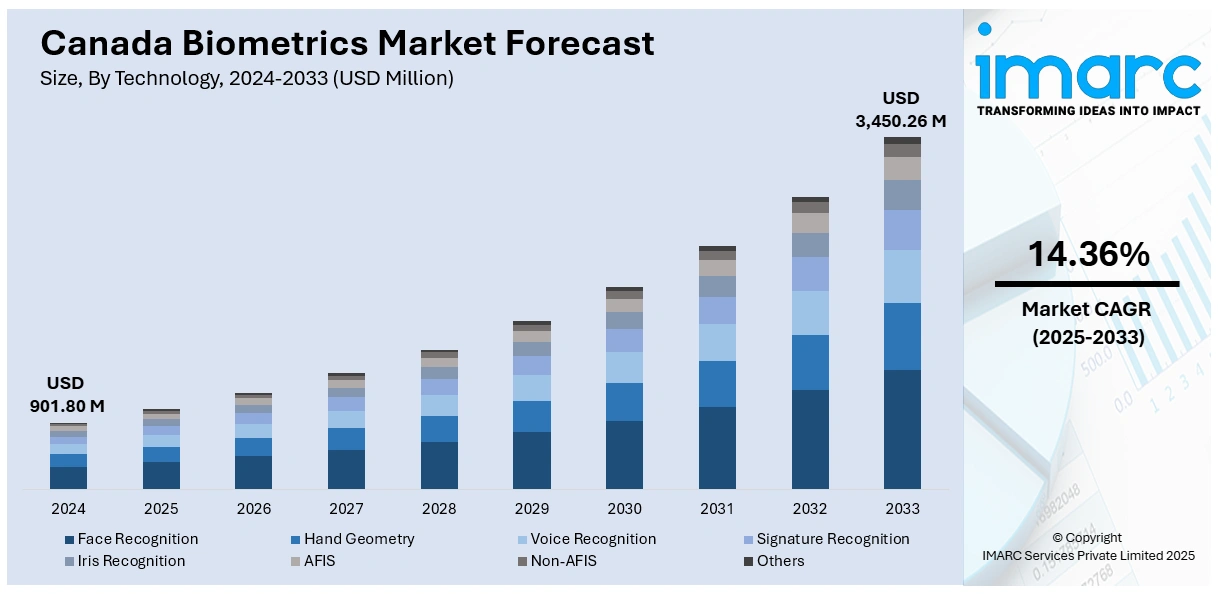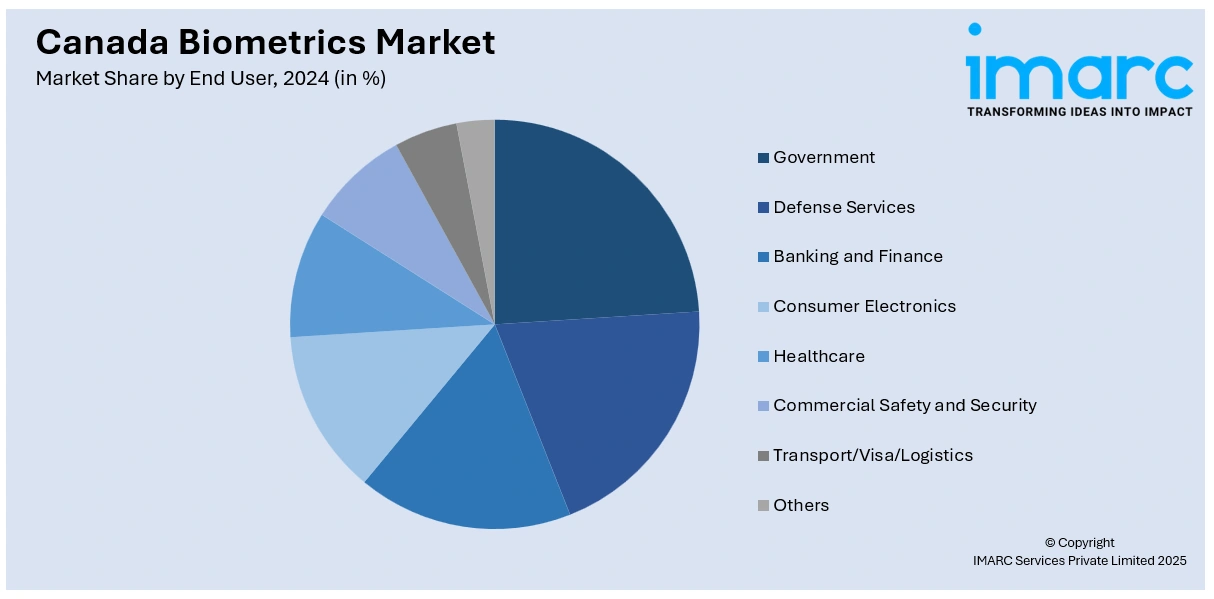
Canada Biometrics Market Size, Share, Trends and Forecast by Technology, Functionality, Component, Authentication, End User, and Region, 2025-2033
Canada Biometrics Market Overview:
The Canada biometrics market size reached USD 901.80 Million in 2024. Looking forward, the market is projected to reach USD 3,450.26 Million by 2033, exhibiting a growth rate (CAGR) of 14.36% during 2025-2033. The market is experiencing steady growth, driven by increasing adoption of advanced identification technologies in sectors such as banking, government, and security. Rising concerns over data security and identity fraud are boosting demand for fingerprint, facial, and iris recognition systems. Technological innovations and integration with digital services are further supporting market expansion. The growing focus on secure authentication methods further continue to strengthen the Canada biometrics market share.
|
Report Attribute
|
Key Statistics
|
|---|---|
|
Base Year
|
2024
|
|
Forecast Years
|
2025-2033
|
|
Historical Years
|
2019-2024
|
| Market Size in 2024 | USD 901.80 Million |
| Market Forecast in 2033 | USD 3,450.26 Million |
| Market Growth Rate 2025-2033 | 14.36% |
Canada Biometrics Market Trends:
Contactless Biometric Solutions
The growing use of contactless biometric technologies is playing a key role in the expansion of the biometrics market in Canada. As public awareness around hygiene and health concerns rises, various organizations and government bodies are focusing on touchless authentication methods like facial recognition, iris scanning, and voice recognition. For instance, in November 2024, Air Canada introduced facial recognition technology at Vancouver International Airport, allowing domestic passengers to board without physical ID. The voluntary program enables users to upload a photo and passport scan via the airline's app, aiming to streamline the boarding process. These solutions allow for secure and rapid identification without any physical contact, making them particularly suitable for busy places such as airports, healthcare facilities, corporate offices, and public transit hubs. Beyond promoting hygiene, contactless biometrics also improve user convenience by minimizing wait times and streamlining access control systems. Advances in technology have enhanced their accuracy, even in challenging lighting conditions or when users are wearing masks, which further enhances their utility. The growing demand for these solutions is fueled by the necessity for seamless, efficient security systems that strike a balance between safety and operational speed, establishing contactless biometrics as a fundamental trend in Canada’s changing security landscape.

To get more information on this market, Request Sample
Integration with Digital Identity Programs
The incorporation of biometric authentication into digital identity initiatives is a significant factor influencing Canada biometrics market growth. Government organizations are increasingly utilizing advanced biometric technologies such as fingerprint, facial recognition, and iris scanning for e-passports, national ID systems, and border control applications. These efforts are designed to streamline identity verification processes, enhance national security, and minimize the risks of identity fraud. In e-passports, biometrics facilitate quicker and more secure cross-border travel, while national ID systems provide reliable identification of citizens for public services. Border control solutions harness biometrics to expedite immigration processing and enhance the traveler experience. For instance, in August 2024, the Canada Border Services Agency (CBSA) announced its plans to launch a facial recognition app, ReportIn, this fall for tracking individuals ordered to leave the country. The app replaces outdated voice biometrics and will use Amazon Web Services. Concerns over algorithm transparency and potential bias have been raised regarding its voluntary use. The movement toward digital identity integration also promotes interoperability among government databases, improving the efficiency of security operations. As both public and private sectors emphasize secure and effective identity management, the integration of biometrics is poised to grow further, reinforcing its significance in Canada’s digital transformation.
Canada Biometrics Market Segmentation:
IMARC Group provides an analysis of the key trends in each segment of the market, along with forecasts at the country and regional levels for 2025-2033. Our report has categorized the market based on technology, functionality, component, authentication, and end user.
Technology Insights:
- Face Recognition
- Hand Geometry
- Voice Recognition
- Signature Recognition
- Iris Recognition
- AFIS
- Non-AFIS
- Others
The report has provided a detailed breakup and analysis of the market based on technology. This includes face recognition, hand geometry, voice recognition, signature recognition, iris recognition, AFIS, non-AFIS, and others.
Functionality Insights:
- Contact
- Non-contact
- Combined
A detailed breakup and analysis of the market based on the functionality have also been provided in the report. This includes contact, non-contact, and combined.
Component Insights:
- Hardware
- Software
The report has provided a detailed breakup and analysis of the market based on the component. This includes hardware and software.
Authentication Insights:
- Single-Factor Authentication
- Multifactor Authentication
A detailed breakup and analysis of the market based on the authentication has also been provided in the report. This includes single-factor authentication and multifactor authentication.
End User Insights:

- Government
- Defense Services
- Banking and Finance
- Consumer Electronics
- Healthcare
- Commercial Safety and Security
- Transport/Visa/Logistics
- Others
A detailed breakup and analysis of the market based on the end user has also been provided in the report. This includes government, defense services, banking and finance, consumer electronics, healthcare, commercial safety and security, transport/visa/logistics, and others.
Regional Insights:
- Ontario
- Quebec
- Alberta
- British Columbia
- Others
The report has also provided a comprehensive analysis of all the major regional markets, which include Ontario, Quebec, Alberta, British Columbia, and others.
Competitive Landscape:
The market research report has also provided a comprehensive analysis of the competitive landscape. Competitive analysis such as market structure, key player positioning, top winning strategies, competitive dashboard, and company evaluation quadrant has been covered in the report. Also, detailed profiles of all major companies have been provided.
Canada Biometrics Market News:
- In July 2025, Staffy Health became the first healthcare staffing platform in Canada to implement biometric shift authentication and a one-device-per-worker policy. These innovations enhance shift accuracy, prevent identity fraud, and ensure secure record-keeping. Additionally, a worker reliability rating feature will provide clients with insights into contractor performance for better staffing decisions.
- In July 2025, Canada announced its plans to continue biometric collection services in Sudan through a partnership with the International Organization for Migration. This move, aimed at aiding those unable to safely leave Sudan, allows individuals to complete their applications for permanent residence and resettlement. Appointments are required and will be scheduled by IOM.
- In May 2024, York and Peel Regional Police implemented facial recognition technology to aid investigations, following consultations with the provincial privacy commissioner.
Canada Biometrics Market Report Coverage:
| Report Features | Details |
|---|---|
| Base Year of the Analysis | 2024 |
| Historical Period | 2019-2024 |
| Forecast Period | 2025-2033 |
| Units | Million USD |
| Scope of the Report |
Exploration of Historical Trends and Market Outlook, Industry Catalysts and Challenges, Segment-Wise Historical and Future Market Assessment:
|
| Technologies Covered | Face Recognition, Hand Geometry, Voice Recognition, Signature Recognition, Iris Recognition, AFIS, Non-AFIS, Others |
| Functionalities Covered | Contact, Non-contact, Combined |
| Components Covered | Hardware, Software |
| Authentications Covered | Single-Factor Authentication, Multifactor Authentication |
| End Users Covered | Government, Defense Services, Banking and Finance, Consumer Electronics, Healthcare, Commercial Safety and Security, Transport/Visa/Logistics, Others |
| Regions Covered | Ontario, Quebec, Alberta, British Columbia, Others |
| Customization Scope | 10% Free Customization |
| Post-Sale Analyst Support | 10-12 Weeks |
| Delivery Format | PDF and Excel through Email (We can also provide the editable version of the report in PPT/Word format on special request) |
Key Questions Answered in This Report:
- How has the Canada biometrics market performed so far and how will it perform in the coming years?
- What is the breakup of the Canada biometrics market on the basis of technology?
- What is the breakup of the Canada biometrics market on the basis of functionality?
- What is the breakup of the Canada biometrics market on the basis of component?
- What is the breakup of the Canada biometrics market on the basis of authentication?
- What is the breakup of the Canada biometrics market on the basis of end user?
- What is the breakup of the Canada biometrics market on the basis of region?
- What are the various stages in the value chain of the Canada biometrics market?
- What are the key driving factors and challenges in the Canada biometrics market?
- What is the structure of the Canada biometrics market and who are the key players?
- What is the degree of competition in the Canada biometrics market?
Key Benefits for Stakeholders:
- IMARC’s industry report offers a comprehensive quantitative analysis of various market segments, historical and current market trends, market forecasts, and dynamics of the Canada biometrics market from 2019-2033.
- The research report provides the latest information on the market drivers, challenges, and opportunities in the Canada biometrics market.
- Porter's five forces analysis assist stakeholders in assessing the impact of new entrants, competitive rivalry, supplier power, buyer power, and the threat of substitution. It helps stakeholders to analyze the level of competition within the Canada biometrics industry and its attractiveness.
- Competitive landscape allows stakeholders to understand their competitive environment and provides an insight into the current positions of key players in the market.
Need more help?
- Speak to our experienced analysts for insights on the current market scenarios.
- Include additional segments and countries to customize the report as per your requirement.
- Gain an unparalleled competitive advantage in your domain by understanding how to utilize the report and positively impacting your operations and revenue.
- For further assistance, please connect with our analysts.
 Request Customization
Request Customization
 Speak to an Analyst
Speak to an Analyst
 Request Brochure
Request Brochure
 Inquire Before Buying
Inquire Before Buying




.webp)




.webp)












